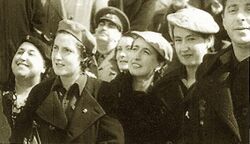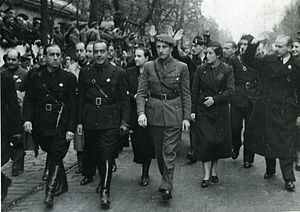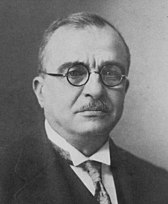7th of November Movement
This article is incomplete because it is pending further input from participants, or it is a work-in-progress by one author. Please comment on this article's talk page to share your input, comments and questions. Note: To contribute to this article, you may need to seek help from the author(s) of this page. |
The 7th of November Movement (Luzelese: Movimento 7 de Novembro), was the official name of the reformed Paretian governing institution of the New Nation of Paretia Party under Carlos Palmeira and Roberta II. It's ideology was nationalist functionalist. The totalitarian government of Palmeira was similar to that of Functionalist Gaullica. It retained close relations with other functionalist powers before and during the Great War, the regime fell when Etruria had conquered Paretia in the late stages of the war.
History
Creation
Before the takeover in November 1925, the PNNP had become loose allies with other groups in the country, the military, the monarchy, catholics, and traditionalists. The second-in-command of the PNNP, Alfonso Clemente, was essential in his role for reaching out to these groups and putting them under the wing of the PNNP. These groups played a major role in their takeover in ther 1925 Paretian coup on the 7th of November.
After the coup and Roberta II's appointed of Palmeira to Premier, Clemente became Deputy Premier of the new government, he also was the Minister of Government Affairs. In order to keep their new allies inside the new government, Palmeira, Clemente, and Roberta II would found the 7th of November Movement.
Palmeira became the Chief of the Movement, Roberta was made the Lady of the Movement. Clemente was named the first General Secretary of the Movement, which was real power for the new umbrella organization. He would coodinate the acceptance of new groups into the PNNP's government. The Coalition Decree in 1925 would bring in the Monarquistas Absolutistas and the Obrigé paramilitaries under their wing. Their leader, Fidel Colón, became Deputy Premier under Palmeira. The Obrigé's leader, Xuaco Parrondo, became the second-in-command of the Reservistas paramilitary organization.
Pre-war
The 7th of November Movement included the PNNP, other functionalist groups, traditionalists, national catholics, monarchists, and military leaders.
In 1926 the organization would create the National Youth Organization, a massive youth front that would become one of the largest in the world. It played an essential role in the government's events and actions.
A major blow to the PNNP would occur in 1927, when Tomás Gama Cerqueira, a member of the SPIO's resistance organization the Paretian Workers Brigades, would shoot and kill Clemente during a rally. This greatly angered Palmeira and the government, who would ramp up actions against resistance and further put serveillance groups across the nation.
This would upset Palmeira very much. He would give a speech on what would be further totalitarian measures to be made by the government of Paretia. "See what they do to our colleague and friend Clemente. These tumors, they wish to steal, leech, and destory the society they are apart of. We will eradicate them, they can not hide from our watch if we work together to stop them."
Clemente was succeeded by Luca Nicolau Mendonça, a traditionalist-turned PNNP member. Palmeira saw him as a unifier between the different groups the 7th of November Movement. Later that year, the secret police force, the Segurança, would go out and commit killings of relatives of resistance members.
The 7th of November Movement held massive rallies, the largest in 1927 that saw over 100,000 in attendance. Many of these rallies were supported by the ONJ. Palmeira called rallies "a celebration of our nation's health, a time for reinvigoration and igniting the flame of the nation." Propaganda Minister Hèctor Clar would run the state newspaper, Acima, which was helped created by the ONJ. A tactic used by the government to subvert enemies was to create false newspapers from opposition to spread damaging information about them. The functionalist government would create the first state radio broadcast company, Paretian State Radiotelevision.
Wartime
The Great War's outbreak lead to a shift towards the military members of the government gaining more control. Many of them were already functionalists, including Rafael Azevedo, who was Minister of the Interior. He became the next leader of the Movement in 1928. Azevedo was a strongman, who wanted complete and strict organization within the government. He would want to make sure all of the members of the Movement were in line.
Clar and Azevedo were close friends, as well as close to Queen Roberta II. Azevedo and Clar would work with the Queen to mobilize the army in what Palmeira called "a war for the survival of the nation" against Etruria, who joined the war in 1928.
Mobilization of the ONJ and Reservistas would occur in 1928 with many of the latter being send to the front lines as shock troops. The Reservistas' Pérolitas, an all-female wing of the paramilitary, became under the influence of the PNNP Feminine Section. Roberta II would organize some of the Pérolitas into espionage groups.

The government would encourage attacks against Etrurians who were not in line with the government. In areas with Etrurian communities, many Etrurians were attacked by mobs. Initially the Etrurian forces were stopped at the Palmeira Line, a wall of defenses in southwest Esmeira. The Eturian forces would be pushed back into Etruria with Gaullican help in 1929, a push known as Operation Teatro. Soldiers of Paretia including Reservistas would commit the Bulaga Massacre during this offensive.
Paretian and Gaullican forces would attempt to push into Etruria but were stopped at the Battle of Turania. The Pareto-Gaullican force would be pushed back into Esmeira by 1930. In 1929 the government would move more towards having military leaders in it's top positions, General Domingos Queiros Borges would become General Secretary of the Movement in 1929 to 1930. in 1930 Defense Minister Joaquim Fidalgo and Palmeira made a speech calling the war a "Battle for existance of the Paretian people."
Resistance groups were gaining traction with the war, the government would us groups like the Pérolitas and the Segurança to attack them and deter further dissent. In November 1930 Leader of the Pérolitas Izabel Grilo would publically hang over 300 people, including women and children for "collaborating with the enemy".
In 1931 and 1932 the front lines becaem very stagnant, but Etrurian forces were making gains towards the Espiesa River and Teradad.
WIP
Leadership
The Movimento 7 de Novembro was lead by Carlos Palmeira, given the title National Chief of the New Nation of Paretia Party and the 7th of November Movement Board, or shortly known as "O Chefe", and was assisted by the General Secretary of the 7th of November Movement. Queen Roberta II was given the traditional title Lady of the Movement, known shortly as "A Dama".
Composition
- Sole Legal Party: The New Nation of Paretia Party was the sole legal political party their takeover in 1925. All other parties had become prohibited by the government of Palmeira and Roberta.
- Sole Trade Union: The Sindicato Unido de Paretia was the sole legal trade union in the country under the PNNP. All other trade unions were banned and all workers and employers were required to be apart of it.
- Sole Ideology: The sole legal ideology of Paretia was National Functionalist Palmeirism, the Paretian variant of functionalism and the central ideology of the PNNP. Heavily inspired by functionalism's idea of the nation as an organism. Palmeira often used biological terminology in his speeches, such as preserving the nation's "health", calling percieves enemies "diseases", "viruses", or "ailments".
Ideology
The central ideology of the movement was National Functionalist Palmeirism, the Paretian variant of the Gaullican-born ideology of national functionalism. It believes in a authoritarian society that which promotes and "preserves the culture, faith, and existance of a nation". It is inspired by Gaullican functionalism that includes syndicalist and traditionalist elements to it, which Palmeira considered harmony of the working classes "essential" to the nation. This Paretian Functionalist Syndicalist Traditionalist variant of the ideology became known as Palmeirism, after Palmeira himself.
The Movement stated to be both anti-capitalist and anti-socialist. Claiming the former as at fault for the failure of nations, and the latter at fault for destroying nations. The movement wanted to destroy class conflict and unite them into collaboration. They would create a sole trade union for all of the country to be apart of, known as the United Syndicate of Paretia that would include both employers and workers.
The government would begin numerous nationa projects to reinvigorate the economy which was at the time decimated by the Great Collapse. They would also support wage increases but also would ban striking.
The Movement promoted the authority of the monarchy and traditionalism. It promoted the idea that Paretian culture was the world's greatest and should be protected in every part of society. Roberta II being a member of the PNNP and the New State Movement further lead to this ideal becoming prominant, the title "Lady of the Movement" was given to the Queen.
Religion is also a major part of the ideology, Integralism and National catholicism were major parts of the Movement's ideals. The movement believe that the rules of catholic faith should be applied to society, increasingly merging the church and state together. Religious minorities were targeted by the pro-Catholic government, groups such as Amendists, Atudites, and Irfanis were deported or discriminated against during the Movement's rule.
In similarity to Duclerque's "nostalgic future", Palmeira refered to as "progress in tradition". He often mixes science and religion in his speeches. Calling the future, "lead by God's scientific wonders".
Racial purity ideals were also promoted by the ideology, heavily being inspired by the idea of Blanchiment of Gaullican National Functionalism, in Paretian it was called Branqueamento. Anti-Rahelian and Anti-Bahian sentiment was rampant, the New State would deport many of these groups to Tsabara. Non-Paretian groups such as Etrurians were also deported to Etruria during the rule of the 7th of November Movement.
Based on Trintignant's idea of violence as a basic part of the human condition, the government of Palmeira used violence early on during it's rise to power and continued to do so during their ruled. Using paramilitaries like the Reservistas, and the secret police force the Segurança.
Militarism and expansionism were also apart of the ideology, many of the Novo Palmeiristas were military officers who sought power. Military strength was greated before the outbreak fo the Great War. Expansionist sentiment was also rampant, Palmeira promoted ideas that Paretia should become a colonial power once more, and targeted Etrurian colonial claims such as in Rahelia and Emessa. They also sought expansion into Bahia. Claims over parts of northeast Etruria also existed.
Civic nationalism in the sense of national functionalism was promoted by Palmeira's regime, the idea of Paretia as a union of four peoples had already existed, but during the reign if the functionalists it was more on the lines of Paretia as one, eradicating any separatist thoughts was apart of the regime. Separatist groups would rise up out of this, fearing that their peoples would be targeted. The separate languages were still taught, but cultural identity became solely Paretian. The massive National Youth Organization would be used to promote civic nationalism amongst the youth.
Despite bringing in traditionalist and monarchist elements, the government of the PNNP would bring in the functionalist rejection of royal decadence. Roberta II would rid herself of the traditional regal garb for a more miliaristic and simple outfit. As part of the new 7th of November Movement, Palmeira would announce a synthesis of the past and future, especially combining religious symbolism in a modern style. Art and culture in the country would embrace futurism and surrealism mixed with nationalism.
Familias
The government had different factions that had become allies of the government of the PNNP. These factions were known as familias. The members of the original movement of the PNNP became known the Palmeiristas. New members of the movement after the 1925 election were considered opportunist by outsiders, and became known as the Novos Palmeiristas, many of them were members of the military who took advantage of the political situation and allied with the PNNP.
Other movements in the country had been allowed as apart of the PNNP's 7th of November Movement, including the monarchist traditionalist Monarquistas Absolutistas, which were a traditionalist and conservative group that had advocated for more power to Roberta II.
Other traditionalist movements included the Católicos Nacionais, which advocated for the combination of religion and state, especially the Solarian Catholic Church. These absolutist and religious movements supported the idea of Paretidade, a cultural unification of Paretian peoples in Euclea and the Asterias.
Another familia was the military faction of the government, made up of many oppoertunists who sought to have more military say in the regime. These included many generals and commanders, but many low ranking members of the military as well. This faction gained much more power during the Great War.
One more of the families were the socialistas reformados, these were former members of parties like the AR-SRP and SPIO who became aligned with the PNNP later on, many of them forming parties like the Nationalist Syndicalist Movement which merged with the PNNP before the 1925 coup.
List of General Secretaries of the Movimento 7 de Novembro
| No. | Name (Born–Died) |
Portrait | Term in Office | |
|---|---|---|---|---|
| 1 | Alfonso Clemente (1901-1927) |
 |
7 November 1925 | 11 June 1927 |
| 2 | Luca Nicolau Mendonça (1870-1936) |
 |
11 June 1927 | 12 October 1928 |
| 3 | Rafael Azevedo (1874-1934) |
 |
12 October 1928 | 7 November 1929 |
| 4 | Domingos Queiros Borges (1884-1944) |
 |
7 November 1929 | 20 July 1931 |
| 5 | Rafael Azevedo (1874-1934) |
 |
20 July 1931 | 15 June 1933 |
| 5 | Diego Montaña Negro (1885-1935) |
 |
15 June 1933 | 1 October 1933 |






